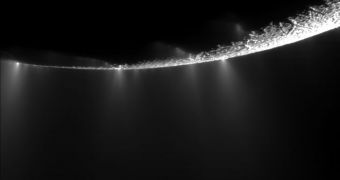Mission controllers at the NASA Jet Propulsion Laboratory (JPL), in Pasadena, California, announce that the Cassini spacecraft will carry out a new flyby of the Saturnine moon Enceladus today, October 19. As it will attempt to image the object's geysers, the probe will use light from stars in Orion's Belt.
At the time when the flight maneuver will be conducted, two of these three stars will be located right behind Enceladus' water and ice plumes, as seen from Cassini's point of view. The spacecraft will therefore use its ultraviolet imager instrument to photograph the plums.
Two thirds of Orion's Belt will act as a backlight, enabling the space probe to collect datasets of exquisite quality. The flyby represents the first time that astronomers have access to a dual stellar occultation, as in two stars to use as backlight.
The new maneuver will take Cassini – a 14-year-old spacecraft – about 765 miles (1,230 kilometers) above Enceladus' surface. The probe has been analyzing the gas giant, its ring system and its moons since achieving orbital insertion, back on July 1, 2004.

 14 DAY TRIAL //
14 DAY TRIAL //